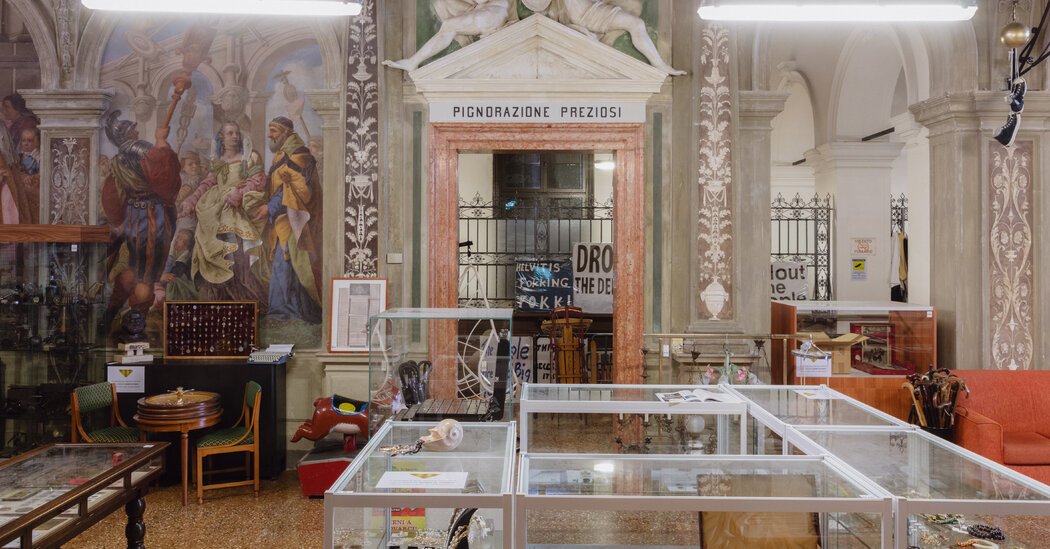Ascending the grand marble staircase in the center of the Venetian palazzo, you encounter a selection of fake Gucci, Hermes and other luxury handbags laid out on a blanket. A street hawker seems to have been disturbed, leaving their knockoff wares behind.
Then, turning right on the mezzanine level, you climb another staircase into a control room. A bank of live CCTV monitors flicker above an empty office chair and espresso-stained plastic coffee cup.
Next, a room for cryptocurrency traders with whirring servers, and a fridge, quarter-filled with tins of Red Bull; followed by the recording studio of a grandmother-aged TikTok influencer; a washroom with a print of Leonardo’s $450.3 million “Salvator Mundi” pasted to the wall; a 1950s-style cocktail bar; a pole dancing den; a kitchen filled with untouched trash. Room after room looks recently abandoned.
These are just a few of the many elements of “Monte di Pietà,” a sprawling, multilayered project by the Swiss-born artist Christoph Büchel, 57, at The Prada Foundation in Venice through Nov. 24. Though not part of the official Biennale program, this is currently the most-talked about art project in Venice, compelling in its obsessive, allusive and sometimes hilarious attention to detail. Never shy of taking on big subjects, Büchel has created an immersive environment that asks awkward, urgent questions about what capitalism is doing to our society and our planet.
To do this, the artist transformed the first three floors of Ca’ Corner della Regina, an 18th-century palace that the Prada Foundation now owns, into the venue for a fictional liquidation auction of a bankrupt “Venice Pawn Shop.” From 1834 to 1969, the palazzo, overlooking the Grand Canal, was the home of the “Mount of Piety,” a Catholic institution that made loans to low-income borrowers who offered their valuables as collateral.
Büchel has imagined this lending facility as if it has just gone bust. The borrowers’ deposited belongings are up for auction and the palazzo is boarded up and covered with “For Sale” signs. The property is a “great investment opportunity,” according to the deadpan accompanying brochure, styled like a bankruptcy court auction catalog.
Büchel does not give media interviews. But the material the artist has chosen for this project has plenty to say about the troubled world we live in, and the roles that capital, debt, spurious notions of value and naked greed have played over the centuries.
Jarring juxtapositions of objects are everywhere. An entire room full of vellum-bound banking records, dating back to the 16th century, is placed next to a job lot of washing machines and dryers. An authentic 1542 Titian portrait, from the Uffizi Gallery in Florence, hangs on a pegboard panel beside a plastic coat hanger.
Büchel’s ongoing work “The Diamond Maker,” consisting of a suitcase filled with a collection of lab-grown diamonds made out of his own destroyed art (he used his own excrement as the organic “starter” for the gems series) is displayed near six original tins of Piero Manzoni’s 1961 fecal masterwork, “Merda d’artista.” An 18th-century map of Ukraine hangs next to some assault rifles.
A Lehman Brothers sign stands on its side behind a screen indicating the current state of world debt (currently more than $72 trillion, according to Worlddebtclocks.com). An official portrait of a smiling Prime Minister Giorgia Meloni of Italy is placed on a cardboard box next to the ground floor restrooms. A palace, owned by one of the world’s most powerful luxury fashion brands, is filled with the thrift store smell of old clothes.
In the current economic climate, it is difficult to imagine a publicly funded museum having the resources to mount this kind of exhibition. Chiara Costa, the head of programs at the Prada Foundation, said in an email that her team had spent two years working with Büchel to research and produce this project.
Over the last 30 years, the Foundation has often commissioned “utopian projects that are seemingly impossible to realize,” according to Costa. “Monte di Pietà” pushes this mission even further, since “Büchel’s work tends to force the limits of an art institution,” she added, referring to the daunting challenges posed by the artist’s notoriously ambitious and provocative installations.
Unlike Büchel’s more ill-fated schemes — including the unrealized “Training Ground for Democracy,” a would-be dystopian American town that almost bankrupted the Massachusetts Museum of Contemporary Art before it was canceled in 2007 — “Monte di Pietà” is a focused response to a specific building, in a location with specific issues.
One response to these local issues is a cryptocurrency Büchel has created for the project, called the Schei, which is only available to Venice’s ever-diminishing local population. Residents can take 100,000 of these tokens free of charge and trade them; any value created by selling them will be “reinvested into initiatives to benefit citizens and residents of Venice,” according to the token’s website. (Etherscan, which tracks the trade in crypto tokens, has so far recorded just a tiny handful of transactions.)
Back in the project space, a video shows the hapless TikTok “granfluencer,” Regina de’ Schei trying and failing to buy a glass of Prosecco with her crypto tokens.
What all this adds up to is every visitor’s guess. Of course, the auction scheduled in the catalog for Nov. 25 will not take place. It is a fiction: The project will simply close. The borrowed artworks will be returned to their lenders and most of the other materials will return to charity shops, according to Costa from the Prada Foundation.
The Palazzo Ca’ Corner della Regina will not be sold. The foundation will reopen the space with another spectacular contemporary art exhibition. Millions of tourists will continue to crowd into Venice. But the wider sense of bankruptcy that Büchel so powerfully articulated won’t go away.
Read More: This Enormous Artwork Turns a Palace Into a Pawnshop


